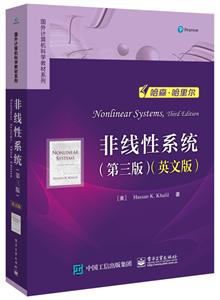包郵 國(guó)外計(jì)算機(jī)科學(xué)教材系列非線(xiàn)性系統(tǒng)(第3版)(英文版)/(美)HASSAN K.KHALIL
-
>
闖進(jìn)數(shù)學(xué)世界――探秘歷史名題
-
>
中醫(yī)基礎(chǔ)理論
-
>
當(dāng)代中國(guó)政府與政治(新編21世紀(jì)公共管理系列教材)
-
>
高校軍事課教程
-
>
思想道德與法治(2021年版)
-
>
毛澤東思想和中國(guó)特色社會(huì)主義理論體系概論(2021年版)
-
>
中醫(yī)內(nèi)科學(xué)·全國(guó)中醫(yī)藥行業(yè)高等教育“十四五”規(guī)劃教材
國(guó)外計(jì)算機(jī)科學(xué)教材系列非線(xiàn)性系統(tǒng)(第3版)(英文版)/(美)HASSAN K.KHALIL 版權(quán)信息
- ISBN:9787121357367
- 條形碼:9787121357367 ; 978-7-121-35736-7
- 裝幀:一般膠版紙
- 冊(cè)數(shù):暫無(wú)
- 重量:暫無(wú)
- 所屬分類(lèi):>>
國(guó)外計(jì)算機(jī)科學(xué)教材系列非線(xiàn)性系統(tǒng)(第3版)(英文版)/(美)HASSAN K.KHALIL 本書(shū)特色
適讀人群 :本書(shū)既可以作為研究生**學(xué)期非線(xiàn)性系統(tǒng)課程的教材,也可以作為工程技術(shù)人員、應(yīng)用數(shù)學(xué)專(zhuān)業(yè)人員的自學(xué)教材或參考書(shū)。 美國(guó)密歇根州立大學(xué)電氣與計(jì)算機(jī)工程專(zhuān)業(yè)的研究生教材,全書(shū)內(nèi)容按照數(shù)學(xué)知識(shí)的由淺入深分成: ■ 基本分析。介紹非線(xiàn)性系統(tǒng)的基本概念和基本分析方法 ■ 反饋系統(tǒng)分析。介紹輸入-輸出穩(wěn)定性、無(wú)源性和反饋系統(tǒng)的頻域分析 ■ 現(xiàn)代分析。介紹現(xiàn)代穩(wěn)定性分析的基本概念、擾動(dòng)系統(tǒng)的穩(wěn)定性、擾動(dòng)理論和平均化以及奇異擾動(dòng)理論 ■ 非線(xiàn)性反饋控制。介紹反饋控制的基本概念和反饋線(xiàn)性化,并給出了幾種非線(xiàn)性設(shè)計(jì)工具。如滑模控制、李雅普諾夫再設(shè)計(jì)、反步設(shè)計(jì)法、基于無(wú)源的控制和高增益觀測(cè)器等
國(guó)外計(jì)算機(jī)科學(xué)教材系列非線(xiàn)性系統(tǒng)(第3版)(英文版)/(美)HASSAN K.KHALIL 內(nèi)容簡(jiǎn)介
非線(xiàn)性系統(tǒng)的研究近年來(lái)受到越來(lái)越廣泛的關(guān)注,國(guó)外許多工科院校已將"非線(xiàn)性系統(tǒng)”作為相關(guān)專(zhuān)業(yè)研究生的學(xué)位課程。本書(shū)是美國(guó)密歇根州立大學(xué)電氣與計(jì)算機(jī)工程專(zhuān)業(yè)的研究生教材,全書(shū)內(nèi)容按照數(shù)學(xué)知識(shí)的由淺入深分成了四個(gè)部分。基本分析部分介紹了非線(xiàn)性系統(tǒng)的基本概念和基本分析方法;反饋系統(tǒng)分析部分介紹了輸入-輸出穩(wěn)定性、無(wú)源性和反饋系統(tǒng)的頻域分析;現(xiàn)代分析部分介紹了現(xiàn)代穩(wěn)定性分析的基本概念、擾動(dòng)系統(tǒng)的穩(wěn)定性、擾動(dòng)理論和平均化以及奇異擾動(dòng)理論;非線(xiàn)性反饋控制部分介紹了反饋線(xiàn)性化,并給出了幾種非線(xiàn)性設(shè)計(jì)工具,如滑模控制、李雅普諾夫再設(shè)計(jì)、反步設(shè)計(jì)法、基于無(wú)源性的控制和高增益觀測(cè)器等。此外本書(shū)附錄還匯集了一些書(shū)中用到的數(shù)學(xué)知識(shí),包括基本數(shù)學(xué)知識(shí)的復(fù)習(xí)、壓縮映射和一些較為復(fù)雜的定理證明。本書(shū)已根據(jù)作者于2017年2月更新過(guò)的勘誤表進(jìn)行過(guò)更正。
國(guó)外計(jì)算機(jī)科學(xué)教材系列非線(xiàn)性系統(tǒng)(第3版)(英文版)/(美)HASSAN K.KHALIL 目錄
Contents
1 Introduction
1.1 Nonlinear Models and Nonlinear Phenomena
1.2 Examples
1.2.1 Pendulum Equation
1.2.2 Tunnel-Diode Circuit
1.2.3 Mass-Spring System
1.2.4 Negative-Resistance Oscillator
1.2.5 Artificial Neural Network
1.2.6 Adaptive Control
1.2.7 Common Nonlinearities
1.3 Exercises
2 Second-Order Systems
2.1 Qualitative Behavior of Linear Systems
2.2 Multiple Equilibria
2.3 Qualitative Behavior Near Equilibrium Points
2.4 Limit Cycles
2.5 Numerical Construction of Phase Portraits
2.6 Existence of Periodic Orbits
2.7 Bifurcation
2.8 Exercises
3 Fundamental Properties
3.1 Existence and Uniqueness
3.2 Continuous Dependence on Initial Conditions and Parameters
3.3 Differentiability of Solutions and Sensitivity Equations
3.4 Comparison Principle
3.5 Exercises
4 Lyapunov Stability
4.1 Autonomous Systems
4.2 The Invariance Principle
4.3 Linear Systems and Linearization
4.4 Comparison Functions
4.5 Nonautonomous Systems
4.6 Linear Time-Varying Systems and Linearization
4.7 Converse Theorems
4.8 Boundedness and Ultimate Boundedness
4 9 Input-to-State Stability
4.10 Exercises
5 Input-Output Stability
5.1 L Stability
5.2 L1 Stability of State Models
5.3 L2 Gain
5.4 Feedback Systems: The Small-Gain Theorem
5.5 Exercises
6 Passivity
6.1 Memoryless Functions
6.2 State Models
6.3 Positive Real Transfer Functions
6.4 L2 and Lyapunov Stability
6.5 Feedback Systems: Passivity Theorems
6.6 Exercises
7 Frequency Domain Analysis of Feedback Systems
7.1 Absolute Stability
7.1.1 Circle Criterion
7.1.2 Popov Criterion
7.2 The Describing Function Method
7.3 Exercises
8 Advanced Stability Analysis
8.1 The Center Manifold Theorem
8.2 Region of Attraction
8.3 Invariance-like Theorems
8.4 Stability of Periodic Solutions
8.5 Exercises
9 Stability of Perturbed Systems
9.1 Vanishing Perturbation
9.2 Nonvanishing Perturbation
9.3 Comparison Method
9.4 Continuity of Solutions on the Infinite Interval
9.5 Interconnected Systems
9.6 Slowly Varying Systems
9.7 Exercises
10 Perturbation Theory and Averaging
10.1 The Perturbation Method
10.2 Perturbation on the Infinite Interval
10.3 Periodic Perturbation of Autonomous Systems
10.4 Averaging
10.5 Weakly Nonlinear Second-Order Oscillators
10 6 General Averaging
10.7 Exercises
11 Singular Perturbations
11.1 The Standard Singular Perturbation Model
11.2 Time-Scale Properties of the Standard Model
11.3 Singular Perturbation on the Infinite Interval
11.4 Slow and Fast Manifolds
11.5 Stability Analysis
11.6 Exercises
12 Feedback Control
12.1 Control Problems
12.2 Stabilization via Linearization
12.3 Integral Control
12.4 Integral Control via Linearization
12.5 Gain Scheduling
12.6 Exercises
13 Feedback Linearization
13.1 Motivation
13.2 Input-Output Linearization
13.3 Full-State Linearization
13.4 State Feedback Control
13.4.1 Stabilization
13.4.2 Tracking
13.5 Exercises
14 Nonlinear Design Tools
14.1 Sliding Mode Control
14.1.1 Motivating Example
14.1.2 Stabilization
14.1.3 Tracking
14.1.4 Regulation via Integral Control
14.2 Lyapunov Redesign
14.2.1 Stabilization
14.2.2 Nonlinear Damping
14.3 Backstepping
14.4 Passivity-Based Control
14.5 High-Gain Observers
14.5.1 Motivating Example
14.5.2 Stabilization
14.5.3 Regulation via Integral Control
14.6 Exercises
A Mathematical Review
B Contraction Mapping
C Proofs
Note and References
Bibliography
Symbols
Index
國(guó)外計(jì)算機(jī)科學(xué)教材系列非線(xiàn)性系統(tǒng)(第3版)(英文版)/(美)HASSAN K.KHALIL 作者簡(jiǎn)介
美國(guó)密歇根大學(xué)電氣與計(jì)算機(jī)工程系University Distinguished教授。1989年由于其在“奇異擾動(dòng)理論及其在控制中的應(yīng)用”方面的成就被選為IEEE會(huì)士。多年來(lái)一直從事非線(xiàn)性系統(tǒng)的教學(xué)和研究工作,主要研究方向包括非線(xiàn)性(魯棒和自適應(yīng))控制、奇異擾動(dòng)理論和電驅(qū)動(dòng)控制。本書(shū)第二版曾于2002年獲國(guó)際自動(dòng)控制聯(lián)合會(huì)(IFAC)授予的控制工程教材獎(jiǎng)。美國(guó)密歇根大學(xué)電氣與計(jì)算機(jī)工程系University Distinguished教授。1989年由于其在“奇異擾動(dòng)理論及其在控制中的應(yīng)用”方面的成就被選為IEEE會(huì)士。多年來(lái)一直從事非線(xiàn)性系統(tǒng)的教學(xué)和研究工作,主要研究方向包括非線(xiàn)性(魯棒和自適應(yīng))控制、奇異擾動(dòng)理論和電驅(qū)動(dòng)控制。本書(shū)第二版曾于2002年獲國(guó)際自動(dòng)控制聯(lián)合會(huì)(IFAC)授予的控制工程教材獎(jiǎng)。
- >
【精裝繪本】畫(huà)給孩子的中國(guó)神話(huà)
- >
羅曼·羅蘭讀書(shū)隨筆-精裝
- >
小考拉的故事-套裝共3冊(cè)
- >
煙與鏡
- >
二體千字文
- >
隨園食單
- >
中國(guó)歷史的瞬間
- >
詩(shī)經(jīng)-先民的歌唱















